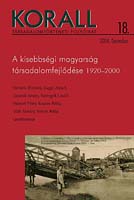Földreform és kolonizáció a Lendva-vidéken a két világháború között
Land Reform and Colonization in the Lendava Region between the Two World War
Author(s): Attila KovácsSubject(s): History
Published by: KORALL Társadalomtörténeti Egyesület
Keywords: social history; 20th century; Hungary; Slovenia; Yugoslavia; Trianon Peace Treaty; Hungarian minority; colonisation
Summary/Abstract: The paper reviews the land reform and the parallel process of colonization in the Lendava Region attached to the newly formed Yugoslavian state during the two World Wars. Primarily we have attempted to find answer to two sets of questions: what were the changes brought about by the distribution of land in the estate structure and ownership composition of the region, and what economic consequences did these changes result in? Besides this, we have also described the changes resulting from the land reform and, especially, the colonization process in the ethnic composition of the Lendava Region and the Hungarian-Slovenian linguistic boundary. Prior to the land reform, the estate structure of the Lendava Region had been bipolar. One typical form was represented by the huge Esterházy estates, in contrast to the other, the multitude of dwarf holdings of less than 15 acres. As a consequence of the land reform, the 23,000-acre Esterházy estate of Lower Lendava was split up. The arable areas were distributed among the colonists and the landless or dwarf holder population of the area, while the estate’s forests were purchased by the firm Našička. The land reform, in itself, bore little fruit economically: the meager lots provided to dwarf holders proved to be insufficient for self-subsistence. Prior to the land reform, the majority of the population of the Lendava Region (82%) had been Hungarian, forming a contiguous ethnic block along the Hungarian-Yugoslav border. The process of colonization performed by the Yugoslav authorities within the framework of the land reform – during which they relocated mainly Slovenians and, to a lesser extent, Croatians to the Lendava Region – disjointed the contiguous Hungarian settlement structure. The fact that during the Yugoslav land reform, only members of the state constituent nation could receive arable land, whereby many ethnic Hungarian emigrated in the hope of a better life, also has a major effect on the ethnic composition of the region.
Journal: Korall - Társadalomtörténeti folyóirat
- Issue Year: 2004
- Issue No: 18
- Page Range: 5-29
- Page Count: 25
- Language: Hungarian

